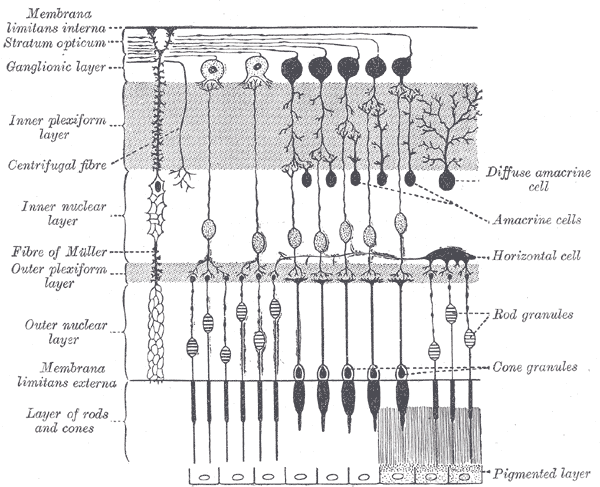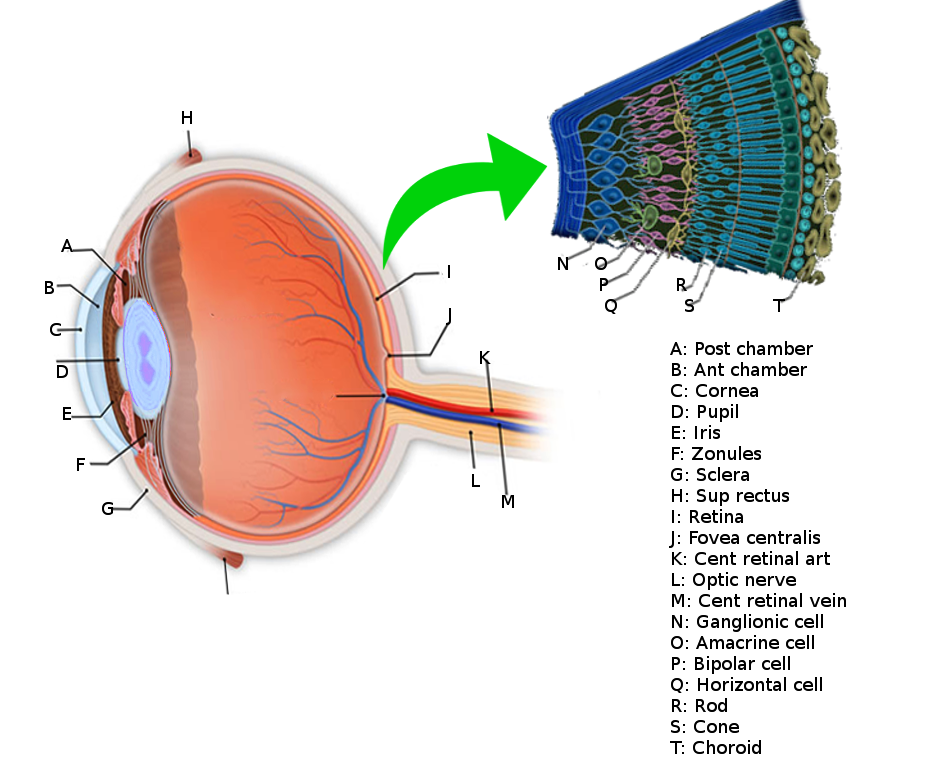[2]
Stevens GA, Bennett JE, Hennocq Q, Lu Y, De-Regil LM, Rogers L, Danaei G, Li G, White RA, Flaxman SR, Oehrle SP, Finucane MM, Guerrero R, Bhutta ZA, Then-Paulino A, Fawzi W, Black RE, Ezzati M. Trends and mortality effects of vitamin A deficiency in children in 138 low-income and middle-income countries between 1991 and 2013: a pooled analysis of population-based surveys. The Lancet. Global health. 2015 Sep:3(9):e528-36. doi: 10.1016/S2214-109X(15)00039-X. Epub
[PubMed PMID: 26275329]
Level 3 (low-level) evidence
[3]
Heavner W, Pevny L. Eye development and retinogenesis. Cold Spring Harbor perspectives in biology. 2012 Dec 1:4(12):. doi: 10.1101/cshperspect.a008391. Epub 2012 Dec 1
[PubMed PMID: 23071378]
Level 3 (low-level) evidence
[4]
Jonas JB, Dichtl A. Evaluation of the retinal nerve fiber layer. Survey of ophthalmology. 1996 Mar-Apr:40(5):369-78
[PubMed PMID: 8779083]
Level 3 (low-level) evidence
[5]
Hartveit E, Veruki ML. Electrical synapses between AII amacrine cells in the retina: Function and modulation. Brain research. 2012 Dec 3:1487():160-72. doi: 10.1016/j.brainres.2012.05.060. Epub 2012 Jul 7
[PubMed PMID: 22776293]
[6]
Tanaka M, Tachibana M. Independent control of reciprocal and lateral inhibition at the axon terminal of retinal bipolar cells. The Journal of physiology. 2013 Aug 15:591(16):3833-51. doi: 10.1113/jphysiol.2013.253179. Epub 2013 May 20
[PubMed PMID: 23690563]
[7]
Euler T, Haverkamp S, Schubert T, Baden T. Retinal bipolar cells: elementary building blocks of vision. Nature reviews. Neuroscience. 2014 Aug:15(8):507-19
[PubMed PMID: 25158357]
[8]
Masland RH. The neuronal organization of the retina. Neuron. 2012 Oct 18:76(2):266-80. doi: 10.1016/j.neuron.2012.10.002. Epub 2012 Oct 17
[PubMed PMID: 23083731]
[9]
Narayan DS, Chidlow G, Wood JP, Casson RJ. Glucose metabolism in mammalian photoreceptor inner and outer segments. Clinical & experimental ophthalmology. 2017 Sep:45(7):730-741. doi: 10.1111/ceo.12952. Epub 2017 May 17
[PubMed PMID: 28334493]
[10]
Spencer C, Abend S, McHugh KJ, Saint-Geniez M. Identification of a synergistic interaction between endothelial cells and retinal pigment epithelium. Journal of cellular and molecular medicine. 2017 Oct:21(10):2542-2552. doi: 10.1111/jcmm.13175. Epub 2017 Apr 12
[PubMed PMID: 28402065]
[11]
Kolb H, Fernandez E, Nelson R, Strauss O. The Retinal Pigment Epithelium. Webvision: The Organization of the Retina and Visual System. 1995:():
[PubMed PMID: 21563333]
[12]
Jia YP, Sun L, Yu HS, Liang LP, Li W, Ding H, Song XB, Zhang LJ. The Pharmacological Effects of Lutein and Zeaxanthin on Visual Disorders and Cognition Diseases. Molecules (Basel, Switzerland). 2017 Apr 20:22(4):. doi: 10.3390/molecules22040610. Epub 2017 Apr 20
[PubMed PMID: 28425969]
[13]
Gong X, Rubin LP. Role of macular xanthophylls in prevention of common neovascular retinopathies: retinopathy of prematurity and diabetic retinopathy. Archives of biochemistry and biophysics. 2015 Apr 15:572():40-48. doi: 10.1016/j.abb.2015.02.004. Epub 2015 Feb 18
[PubMed PMID: 25701588]
[15]
Nickla DL, Wallman J. The multifunctional choroid. Progress in retinal and eye research. 2010 Mar:29(2):144-68. doi: 10.1016/j.preteyeres.2009.12.002. Epub 2009 Dec 29
[PubMed PMID: 20044062]
[19]
Ohno-Matsui K. WHAT IS THE FUNDAMENTAL NATURE OF PATHOLOGIC MYOPIA? Retina (Philadelphia, Pa.). 2017 Jun:37(6):1043-1048. doi: 10.1097/IAE.0000000000001348. Epub
[PubMed PMID: 27755375]
[20]
Ohno-Matsui K, Kawasaki R, Jonas JB, Cheung CM, Saw SM, Verhoeven VJ, Klaver CC, Moriyama M, Shinohara K, Kawasaki Y, Yamazaki M, Meuer S, Ishibashi T, Yasuda M, Yamashita H, Sugano A, Wang JJ, Mitchell P, Wong TY, META-analysis for Pathologic Myopia (META-PM) Study Group. International photographic classification and grading system for myopic maculopathy. American journal of ophthalmology. 2015 May:159(5):877-83.e7. doi: 10.1016/j.ajo.2015.01.022. Epub 2015 Jan 26
[PubMed PMID: 25634530]
[21]
Kubasch AS, Meurer M. [Oculocutaneous and ocular albinism]. Der Hautarzt; Zeitschrift fur Dermatologie, Venerologie, und verwandte Gebiete. 2017 Nov:68(11):867-875. doi: 10.1007/s00105-017-4061-x. Epub
[PubMed PMID: 29018889]
[22]
Preising M, Op de Laak JP, Lorenz B. Deletion in the OA1 gene in a family with congenital X linked nystagmus. The British journal of ophthalmology. 2001 Sep:85(9):1098-103
[PubMed PMID: 11520764]
[23]
Jia X, Yuan J, Jia X, Ling S, Li S, Guo X. GPR143 mutations in Chinese patients with ocular albinism type 1. Molecular medicine reports. 2017 May:15(5):3069-3075. doi: 10.3892/mmr.2017.6366. Epub 2017 Mar 23
[PubMed PMID: 28339057]
[24]
Greenberg PB, Baumal CR. Laser therapy for rhegmatogenous retinal detachment. Current opinion in ophthalmology. 2001 Jun:12(3):171-4
[PubMed PMID: 11389341]
Level 3 (low-level) evidence
[26]
Feltgen N, Walter P. Rhegmatogenous retinal detachment--an ophthalmologic emergency. Deutsches Arzteblatt international. 2014 Jan 6:111(1-2):12-21; quiz 22. doi: 10.3238/arztebl.2014.0012. Epub
[PubMed PMID: 24565273]
[27]
Amer R,Nalcı H,Yalçındağ N, Exudative retinal detachment. Survey of ophthalmology. 2017 Nov - Dec;
[PubMed PMID: 28506603]
Level 3 (low-level) evidence
[28]
Cugati S, Varma DD, Chen CS, Lee AW. Treatment options for central retinal artery occlusion. Current treatment options in neurology. 2013 Feb:15(1):63-77. doi: 10.1007/s11940-012-0202-9. Epub
[PubMed PMID: 23070637]
[29]
Mason JO 3rd, Shah AA, Vail RS, Nixon PA, Ready EL, Kimble JA. Branch retinal artery occlusion: visual prognosis. American journal of ophthalmology. 2008 Sep:146(3):455-7. doi: 10.1016/j.ajo.2008.05.009. Epub 2008 Jul 2
[PubMed PMID: 18599018]
[30]
Hayreh SS, Podhajsky PA, Zimmerman MB. Branch retinal artery occlusion: natural history of visual outcome. Ophthalmology. 2009 Jun:116(6):1188-94.e1-4. doi: 10.1016/j.ophtha.2009.01.015. Epub 2009 Apr 18
[PubMed PMID: 19376586]
[31]
Zając-Pytrus HM, Pilecka A, Turno-Kręcicka A, Adamiec-Mroczek J, Misiuk-Hojło M. The Dry Form of Age-Related Macular Degeneration (AMD): The Current Concepts of Pathogenesis and Prospects for Treatment. Advances in clinical and experimental medicine : official organ Wroclaw Medical University. 2015 Nov-Dec:24(6):1099-104. doi: 10.17219/acem/27093. Epub
[PubMed PMID: 26771984]
Level 3 (low-level) evidence
[32]
Chakravarthy U, Wong TY, Fletcher A, Piault E, Evans C, Zlateva G, Buggage R, Pleil A, Mitchell P. Clinical risk factors for age-related macular degeneration: a systematic review and meta-analysis. BMC ophthalmology. 2010 Dec 13:10():31. doi: 10.1186/1471-2415-10-31. Epub 2010 Dec 13
[PubMed PMID: 21144031]
Level 1 (high-level) evidence
[34]
Kwon YH, Fingert JH, Kuehn MH, Alward WL. Primary open-angle glaucoma. The New England journal of medicine. 2009 Mar 12:360(11):1113-24. doi: 10.1056/NEJMra0804630. Epub
[PubMed PMID: 19279343]
[35]
Kirsch RE, Anderson DR. Clinical Recognition of Glaucomatous Cupping. American journal of ophthalmology. 2018 Sep:193():xxviii-xxxviii. doi: 10.1016/j.ajo.2018.06.008. Epub
[PubMed PMID: 30144901]
[36]
Williams R, Airey M, Baxter H, Forrester J, Kennedy-Martin T, Girach A. Epidemiology of diabetic retinopathy and macular oedema: a systematic review. Eye (London, England). 2004 Oct:18(10):963-83
[PubMed PMID: 15232600]
Level 1 (high-level) evidence
[37]
COGAN DG, TOUSSAINT D, KUWABARA T. Retinal vascular patterns. IV. Diabetic retinopathy. Archives of ophthalmology (Chicago, Ill. : 1960). 1961 Sep:66():366-78
[PubMed PMID: 13694291]
[38]
Vadlapudi AD, Vadlapatla RK, Mitra AK. Current and emerging antivirals for the treatment of cytomegalovirus (CMV) retinitis: an update on recent patents. Recent patents on anti-infective drug discovery. 2012 Apr:7(1):8-18
[PubMed PMID: 22044356]
[39]
Newman H, Gooding C. Viral ocular manifestations: a broad overview. Reviews in medical virology. 2013 Sep:23(5):281-94. doi: 10.1002/rmv.1749. Epub 2013 Jun 25
[PubMed PMID: 23797960]
Level 3 (low-level) evidence
[40]
Fagerholm R, Vesti E. Retinopathy of prematurity - from recognition of risk factors to treatment recommendations. Duodecim; laaketieteellinen aikakauskirja. 2017:133(4):337-44
[PubMed PMID: 29205980]
[41]
International Committee for the Classification of Retinopathy of Prematurity. The International Classification of Retinopathy of Prematurity revisited. Archives of ophthalmology (Chicago, Ill. : 1960). 2005 Jul:123(7):991-9
[PubMed PMID: 16009843]
[43]
Ali MU, Rahman MSU, Cao J, Yuan PX. Genetic characterization and disease mechanism of retinitis pigmentosa; current scenario. 3 Biotech. 2017 Aug:7(4):251. doi: 10.1007/s13205-017-0878-3. Epub 2017 Jul 18
[PubMed PMID: 28721681]
[44]
Mendoza PR, Grossniklaus HE. The Biology of Retinoblastoma. Progress in molecular biology and translational science. 2015:134():503-16. doi: 10.1016/bs.pmbts.2015.06.012. Epub 2015 Jul 14
[PubMed PMID: 26310174]
[45]
Rao R, Honavar SG. Retinoblastoma. Indian journal of pediatrics. 2017 Dec:84(12):937-944. doi: 10.1007/s12098-017-2395-0. Epub 2017 Jun 16
[PubMed PMID: 28620731]
[46]
Nicholson BP, Atchison E, Idris AA, Bakri SJ. Central serous chorioretinopathy and glucocorticoids: an update on evidence for association. Survey of ophthalmology. 2018 Jan-Feb:63(1):1-8. doi: 10.1016/j.survophthal.2017.06.008. Epub 2017 Jun 30
[PubMed PMID: 28673727]
Level 3 (low-level) evidence
[47]
Liew G, Quin G, Gillies M, Fraser-Bell S. Central serous chorioretinopathy: a review of epidemiology and pathophysiology. Clinical & experimental ophthalmology. 2013 Mar:41(2):201-14. doi: 10.1111/j.1442-9071.2012.02848.x. Epub 2012 Sep 21
[PubMed PMID: 22788735]
[48]
Cole BL. Assessment of inherited colour vision defects in clinical practice. Clinical & experimental optometry. 2007 May:90(3):157-75
[PubMed PMID: 17425762]
[49]
HENRY GH, COLE BL, NATHAN J. THE INHERITANCE OF CONGENITAL TRITANOPIA WITH THE REPORT OF AN EXTENSIVE PEDIGREE. Annals of human genetics. 1964 Mar:27():219-31
[PubMed PMID: 14128207]
[50]
Tsang SH, Sharma T. Rod Monochromatism (Achromatopsia). Advances in experimental medicine and biology. 2018:1085():119-123. doi: 10.1007/978-3-319-95046-4_24. Epub
[PubMed PMID: 30578497]
Level 3 (low-level) evidence
[51]
Aboshiha J, Dubis AM, Carroll J, Hardcastle AJ, Michaelides M. The cone dysfunction syndromes. The British journal of ophthalmology. 2016 Jan:100(1):115-21. doi: 10.1136/bjophthalmol-2014-306505. Epub 2015 Mar 13
[PubMed PMID: 25770143]
[52]
Jiang S, Franco YL, Zhou Y, Chen J. Nanotechnology in retinal drug delivery. International journal of ophthalmology. 2018:11(6):1038-1044. doi: 10.18240/ijo.2018.06.23. Epub 2018 Jun 18
[PubMed PMID: 29977820]
[53]
Bozzuto G, Molinari A. Liposomes as nanomedical devices. International journal of nanomedicine. 2015:10():975-99. doi: 10.2147/IJN.S68861. Epub 2015 Feb 2
[PubMed PMID: 25678787]


